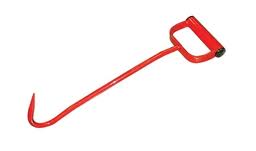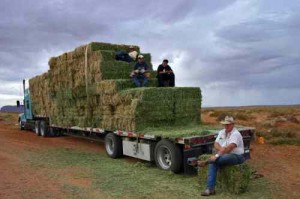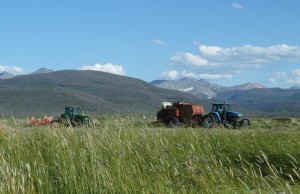-
Archives
- November 2017
- November 2016
- October 2016
- April 2016
- March 2016
- November 2015
- February 2015
- July 2014
- June 2014
- October 2013
- January 2013
- October 2012
- July 2012
- April 2012
- March 2012
- February 2012
- January 2012
- December 2011
- November 2011
- October 2011
- September 2011
- August 2011
- July 2011
- March 2011
- February 2011
- January 2011
- November 2010
- September 2010
- April 2010
- March 2010
- February 2010
- March 2009
- February 2009
- March 2008
- February 2008
- November 2006
- August 2006
- March 2006
- August 2005
- July 2005
-
Meta
Monthly Archives: October 2012
Hay Lady–Part Two
My reverie of disaster is necessarily short lived. Jim’s already hooking, swinging and stacking. And I’m up here to show I’m one of the boys. There’s nothing for it. Pulling my leather gloves tight, I grab my two hay hooks and slam them into the sides of the bale at my feet.

Let me pause here for one word about hay hooks: lethal. Like all proper tools, hay hooks have been refined to suit precisely the work for which they’re designed. Although mostly used as a pair, each unit has a slightly different hook geared to its use not as part of a team, but solo. It’s a divine example of function defining form. In my left hand, I have a hook whose arm is short with a hook acutely angled, ideal for stabbing and lifting. In the other hand is one with a longer shaft and a more open hook angle, making it useful for dragging. When I slam the hooks into each end of the three-foot long bale, it’s like hugging a prickly object with sharp prongs. I can lift and place it just so next to the ones Jim’s already laid end to end, string sides up, on the trailer deck.
At least, that’s the theory. By the time I have moved one bale to its final resting place, Jim’s moved five. Before we’ve jointly repositioned and stacked the first fifteen, Bernard’s tractor is back with the next fifteen. We back our way down the 53-foot trailer, placing one bale parallel to the edge and the next two perpendicular to it. By the time we reach the end, we’ve jointly heaved, swung and shoved about eighty bales into place. That’s barely three tons, with seventeen more to go. Already I’m wiped out.

I set my hands on my hips and blow hard. Even though this isn’t a race, I’ve been keeping score. I know this is sad and distorted, and yet, I can’t help it. Even sadder is that it bothers me that I’m losing badly to Jim, who’s sweating like someone in a Turkish bath. That’s from exertion, since he’s set 75% of the bales so far.
A week ago I railed about how women’s work on a ranch seemed so strictly codified. Now I’m thinking the job of offering sweet rolls and a mug of hot coffee to the trucker sounds pretty good.
Before I have a chance to reconsider, let alone massage my quivering arms, fifteen more bales plummet to the deck. We bend to the task, slinging bales to form the next level of a stack that ultimately will teeter seven bales high. That’ll place me over five yard off the ground. If I do manage to stick with the task till the last level is complete, how the hell am I going to get down? It’ll be like standing on my second floor balcony, not a place from which I’d normally have to clamber with hooks in my hands.
Jim and I complete the second level. By now my shoulders are burning and my wrists are so tired I can barely grip my hay hooks. Every part of my back protests each time I grab a bale and I don’t know which direction I could twist that wouldn’t induce an echoing ache. My mouth and lungs are parched from the dust released from nearly seven tons of dried grass thudding onto the deck. Turning around to preserve some misplaced sense of feminine modesty, I hawk and spit, but come up dry. Whatever saliva I started out has evaporated.
I sit on a bale while Jim continues to stack. He’s got a delivery to make and he can’t do the polite thing and wait around for me to get with the program. I’m long past regretting my decision to help load his truck. Now I’m focused on how to secure myself a graceful exit. The notion of food and drink glimmers in the dusty recesses of my brain. Not being the morning baking type, all I can offer would be toast slices with jam. But I’m sure even that would be welcome, since Jim had to drive three hours to get here by 7:00a.m. And even a hardened hay hauler would welcome some cold juice to wash that down. Plus some strong sweet coffee to perk him up for the long drive down the canyon.

“Hey Jim,” I shout, waving to catch his attention. He places his bale, turning to me with a patient smile. “How about I stop interfering with your progress and go get some cold breakfast for you from the house? I can make you a sack lunch for the road, too.” Truck stop food varies from awful to poisonous, so anything I care to send with him will be appreciated.
Jim is all kindness and support. “Well, girl,” he says. “I don’t know if I can manage this without you.” We look at each other, while I smear dust and dirt around my cheeks with my dirty glove. Hay residue is ground into a fine pale green stain on the front of my jeans. And because I stupidly wore sneakers instead of high boots that would be covered by my jeans, my socks are full of prickly stems. My feet feel like they’re clad in hedgehogs. My hair is in scraggles, having lost contact with my original neat braid long ago.
I want to give Jim a hug, first for putting up with me and second for going along with my hastily conceived exit strategy. But there’s a jumble of bales between us. Bernard, who can’t hear what we’re saying since he’s in the tractor, is already on his way back with more. And I have a suspicion that Jim and I are not yet quite on hugging terms. Ever the gentleman, Jim extends his hand to help me over the bale mountain to where I can carefully climb down from the truck.
It’s official. I’m not a hay stacker. Doubtless I never will be. But I’m happier than I’ve been in a long time. Because I showed that I’m game to try. And I make a mean jam sandwich.
Posted in Dispatches, The Ranch
Leave a comment
Hay Lady–Part One
Hay has taken over my life. I dream about it, measure it, price it, evaluate it, spit its tobacco-y dust out of my mouth and pick errant shreds of it out of my hair.  I’ve rattled and bounced through our hay meadows on a tractor pulling a rake or a baler, watched hawks eyeing the freshly revealed crop of meadow mice from under those bales, seen the late-day sun turn newly baled fields to gold. I can name the grasses that make up our mountain meadow bales and persuade strangers to pay more for it, because it’s better than anyone else’s.
I’ve rattled and bounced through our hay meadows on a tractor pulling a rake or a baler, watched hawks eyeing the freshly revealed crop of meadow mice from under those bales, seen the late-day sun turn newly baled fields to gold. I can name the grasses that make up our mountain meadow bales and persuade strangers to pay more for it, because it’s better than anyone else’s.
I’m thrilled to pieces to be able to explain what I know about hay to others. Backyard horse proprietors, who previously only knew that they wanted their hay to be green, now are walking, talking fountains of hay wisdom, thanks to me. It’s gratifying.
To work with hay haulers, I’ve memorized hay hauling lingo, so I can converse with the drivers in a manner that’ll put them at ease. I figure if we’re using the same terms, they’ll be more inclined to work for me. This is important, because there’s high demand for their services. All the hay in our county is harvested within the same six-week period. And every rancher wants to get their hay away to customers before the snow comes. The haulers can pick and choose for whom they’ll drive. The best ones have unspoken contracts to haul for certain ranches and if I want them to haul for me it’s like the line at the deli counter: take a number and wait your turn.
In my mission to jump the cue, I’m a fountain of arcane data, able to chat about the total length of a typical hay hauling tractor trailer rig, highway height and weight limits, how wide an entry they need in order to turn into someone’s barn yard, and how much I should pay for our hay to be hauled just about anywhere in the lower forty-eight. I know a “tractor” is the engine and cab part of the big rig, and a “cab-over” is a tractor without a snout. There’s no place to sleep in a cab-over, so anyone who drives one figures his drive will be short enough that he can get home to his own, stationary, bed.
A hay hauling trailer has a “head rack” against which the bales of hay are squeezed to pack them into a secure, safely transportable load. A driver whose trailer doesn’t have one is a driver unaccustomed to the work of loading six hundred hay bales by hand and then delivering it all in one piece to someone 150 miles away. And that could mean trouble. I look for trailers with a conveyor belt built into the bed, which mechanically transfers the entire stack of hay down ramps onto the ground on delivery. Clients love them. And anything my clients love makes me happy.
The time comes in every hay lady’s life, when if you’re gonna talk the talk, you have to walk the walk. It’s one thing to know without a shadow of a doubt that our bales average seventy pounds. It’s quite another to fling all that dry grass around personally. One day I set myself the task of doing the hay equivalent of summiting Everest. I’m going to help load a hay truck.
For weeks I’ve watched drivers with a gut big enough to obscure their belt buckle, strap on stiff leather hay chaps, grab hay grapples that would make Captain Hook green with envy, and load their trucks from our hay stacks. “How hard can this be?” I ask myself. “These guys spend their whole day sitting and driving, and they can do it.” Yes, I come from a life where I’ve been adept not just at accomplishing whatever I set out to do, but doing it better than most. And yes, I’ve now spent months outdoors and active. Still, one side of me tentatively raises its hand, wishing to point out that fitness is relative. It respectfully wishes to remind me that every time I heft a bale and bump it up to my pickup bed with my knee, I heave a secret sigh of relief that I only have to lift one. Now I’m offering to lift three hundred, a disconnect between wishful thinking and reality that is startling in its optimism, disturbing in its naivete.
 Jim, today’s hauler, is waiting in the stack yard when we arrive to start loading. As I toss my hay hooks onto the bed and clamber up he looks at me with surprise. “What you know, girl?” he offers, to cover what I imagine is both his pleasure at having some loading assistance and his dismay that the helper for today is me. Having sent the doubt-monger to sit in the corner, I am impressed with what I’m about to do, giddy that I’m going to join the fraternity of true hay acolytes.
Jim, today’s hauler, is waiting in the stack yard when we arrive to start loading. As I toss my hay hooks onto the bed and clamber up he looks at me with surprise. “What you know, girl?” he offers, to cover what I imagine is both his pleasure at having some loading assistance and his dismay that the helper for today is me. Having sent the doubt-monger to sit in the corner, I am impressed with what I’m about to do, giddy that I’m going to join the fraternity of true hay acolytes.
Bernard plunges the tractor grapple down, and hooks fifteen bales at once, which he swings over and carefully sets down on the bare trailer bed. As work arenas go, the bed of a trailer is a far cry from my former office. Although long, it’s only eight feet wide, which means I’m doing a hay cha-cha-cha on the equivalent of an executive’s desk. Instead of files, this particular desktop now is littered with a jumble of hay bales, which we have to straighten and place in a precise pattern if we’re to fit the maximum number of bales into this load.
Stems of dried grass litter the surface, making it as slippery as soap film on a shower floor. I am so aware of all the tragedies that could befall me in this small space that I hardly dare move. Before even arriving on the trailer bed, any of the bales could loosen from the tractor grapple and hit me, changing the connection between my head and my neck forever. A chance misstep as I maneuver over the cluttered bales, and my newly repaired ACL is history. Bumping into Jim could send me flailing off the trailer for a long unhappy fall to the ground, breath gone, back cracked. One hay hook losing its purchase on a bale would mean an instant rotater cuff tear as that bale’s full weight wrenches my shoulder out of its socket. And the damage inflicted if a hay hook finds a purchase in my thigh instead of a bale doesn’t bear dwelling on.
Posted in Dispatches, The Ranch
Leave a comment










